
* After a slow emergence, endurance drones are now an important military asset. This chapter covers the well-known General Atomics Predator / Reaper series of endurance drones.
* Modern US government studies for endurance drones, powered by more or less conventional turbocharged aircraft engines, began with a secret study begun by DARPA in the early 1980s, codenamed TEAL RAIN. Following the study, in 1984 DARPA awarded a $40 million US contract to Leading Systems Incorporated (LSI) of Irvine, California, to build an endurance drone named "Amber". Amber was to be used for photographic reconnaissance, ELINT missions, or as a cruise missile. The US Army, Navy, and Marine Corps were interested, and DARPA eventually passed control over to the Navy. The Navy saw it as a potentially useful system for over-the-horizon support of fleet strike forces.
Amber was designed by a team under Abraham Karem of Leading Systems. Amber was 4.6 meters (15 feet) long, had a wingspan of 8.54 meters (28 feet), weighed 335 kilograms (740 pounds), and was powered by a company-built four-cylinder liquid-cooled piston engine providing 49 kW (65 HP), driving a pusher propeller in the tail. The wing was mounted on a short pylon above the fuselage. The cruise missile version of Amber would discard the wing when it made its final dive on a target. Amber had an inverted-vee tail, which would prove a popular configuration for a pusher drone, since it protected the propeller during take-off and landing. The airframe was made of plastic and composite materials, mostly Kevlar, and the drone had retractable stiltlike tricycle landing gear to ensure propeller clearance. Amber had a flight endurance of 38 hours or more.
The initial contract specified three "Basic Amber" A-45 cruise missile prototypes and three B-45 reconnaissance prototypes. Initial flights were in November 1986, with long-endurance flights the next year. Amber had been a classified program up to then, but in 1987 details of the effort were released.
Amber was only one of a number of different US drone programs in planning at the time; the US Congress became impatient with what was perceived as confusion and duplication of effort. Congress ordered a consolidation of drone programs in 1987, freezing funding until June 1988, when the Pentagon established a centralized "Joint Program Office" for drone development.
Amber survived the consolidation of drone efforts into JPO, resulting in the first "Amber I" reconnaissance drone, which first flew in October 1989. Seven Amber Is were built, and were used in evaluations along with Basic Ambers through 1990. However, funding for reconnaissance assets was being cut, and in 1990 the Amber program was killed. It didn't have strong backing, and it said that Karem, though brilliant, had a blunt and abrasive personality that didn't help his cause. LSI was faced with bankruptcy, and was bought out by General Atomics -- a firm originally focused on nuclear technology, which then diversified into several other directions.
* Amber died, to be quickly resurrected. In 1988, LSI had begun development of a simplified version of the Amber named the "Gnat 750", intended for foreign sales. The Gnat 750 made its first flight in 1989. Its configuration was similar to that of the Amber, except that the Gnat 750's wing was mounted low on the fuselage, instead of being mounted on a pylon on top. The Gnat 750 was somewhat larger than the Amber, but weighed less and could carry a heavier payload.
The Gnat 750 was powered by a Rotax 912 water-cooled flat-four four-cycle engine with 64 kW (85 HP). The drone could fly to an operational area 2,000 kilometers (1,240 miles) away and loiter there for 12 hours before returning home.
___________________________________________________________________
GENERAL ATOMICS GNAT 750:
___________________________________________________________________
wingspan:
10.75 meters (35 feet 4 inches)
length:
5 meters (16 feet 5 inches)
height:
0.75 meters (2 feet 5 inches)
empty weight:
250 kilograms (560 pounds)
max loaded weight:
520 kilograms (1,140 pounds)
maximum speed:
212 KPH (132 MPH / 115 KT)
service ceiling:
7,620 meters (25,000 feet)
endurance:
48 hours
___________________________________________________________________
* Eight Gnat 750s were in development when General Atomics bought out LSI. General Atomics continued the program, which led to a contract from the Turkish government for a number of the drones in 1993.
By that time, the disintegration of the old Communist states of Eastern Europe was in full swing, and the US government wanted to obtain an intelligence asset to help deal with trouble spots in the region, specifically the former Yugoslavia. A contract was issued to General Atomics for Gnat 750s with minor modifications; the Gnat 750s were to be operated by the CIA. The program encountered a number of difficulties, much of them due to bureaucratic factionalism and squabbling. One Gnat 750 crashed during tests when it was hit by a gust of wind from the rear, causing it to indicate zero airspeed. The drone's software decided that meant it had landed, and shut down the engine; the Gnat promptly fell to earth.
Despite such problems, the Gnat 750 effort squeaked through, and in early 1994 the CIA sent a team equipped with a Gnat 750 to Albania to monitor events in the former Yugoslavia. Although the results of the operation were regarded as positive, it also showed some of the difficulties involved in drone operation. The Gnat 750 suffered from a number of bugs and was limited by bad weather as well as "terrain that defies description", as one participant put it.
The original Gnat 750 was followed by an "Improved Gnat" or "I-Gnat" variant, with a turbocharged engine and general overall refinements to increase reliability, reduce maintenance, and enhance capability. The Gnat is apparently out of service, having been replaced by improved derivatives, as per below.
* NASA obtained a derivative of the Gnat 750 named the "Altus" for high-altitude research. The Altus and looked much like the Gnat 750 but had a different fuselage and a longer wingspan. The Altus was 7.2 meters (23 feet 7 inches) long, had a wingspan of 16.9 meters (55 feet 4 inches), and a take-off weight of 725 kilograms (1,600 pounds). It could carry 150 kilograms (330 pounds) to 13.7 kilometers (45,000 feet) with an endurance of 24 hours. The engine was originally a Rotax 912 with a single stage of turbocharging.
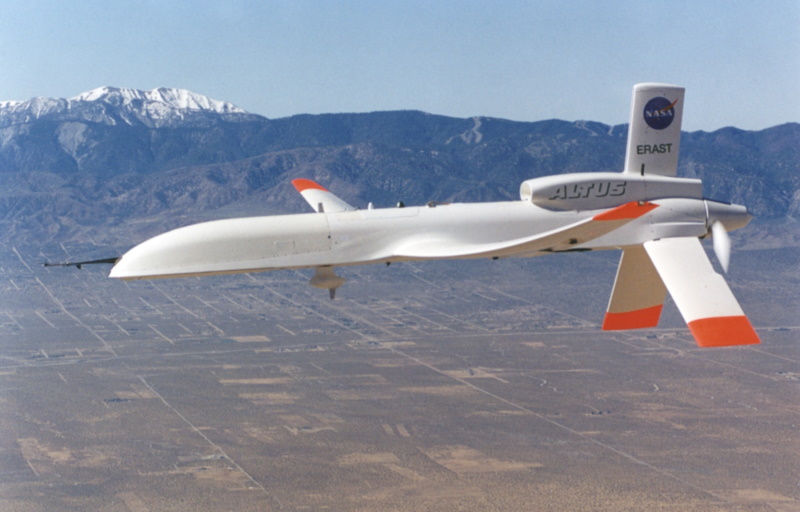
An Altus spent 26 hours above 6,100 meters (20,000 feet) in 1996, and spent four hours above 16,800 feet (55,000 feet) in 1999 after being fitted with a two-stage turbocharger system, updating it to the Altus II configuration.
General Atomics also used the Gnat 750 as the basis for a tactical drone, known as the "Prowler". It looked much like a Gnat 750, but was cut down in size, with a span of 7.31 meters (24 feet) and a length of 4.24 meters (13.9 feet). It had an endurance of over 16 hours, and some commonality with Gnat 750 subsystems. Nobody bought it, and it was abandoned.
BACK_TO_TOP* The Gnat 750 was effectively an interim design, leading to the much more definitive General Atomics "RQ-1 Predator", which went into widespread service. The RQ-1 Predator resembled the Gnat 750 in general configuration, with some clear differences, most significantly the fact that the Predator was much bigger, with about twice the empty weight. While the Gnat 750's fuselage was straight and streamlined, the Predator's fuselage looked something like a plastic spoon turned upside down and faired over underneath, with the bulbous front containing a forward-looking synthetic aperture radar (SAR) peering out through a chin panel, and sensor turret under the nose. The SAR did not prove useful, and was later removed to save weight. Initially, the sensor turret had only an EO-IR imager system; later a laser target designator was incorporated. There was a hardpoint for a stores pylon under each wing.
The Predator was fitted with a number of datalink antennas, for control or data download via a direct RF or satellite link. The drone could provide real-time data to other platforms, such as the J-STARS battlefield surveillance aircraft, or submarines. The Predator took off and landed under remote control, with the "pilot" using a TV camera in the nose of the aircraft, but flew in a preprogrammed pattern, using a GPS-INS guidance system. Like the Gnat-750, it was built largely of composites and powered by a Rotax 912 piston engine, and had a payload capacity of 225 kilograms (500 pounds).
The initial Predator system was designated "RQ-1A", but that designation covered the entire system, the drone having the more specific designation of "RQ-1K". The distinction was confusing and the Air Force finally abandoned it, calling the drone itself the "RQ-1A".
The Predator was designed to keep watch over a battlefield area for a long period of time. If a Predator were flown out of San Francisco, it would be able to operate into Nevada, southern Oregon, or northwestern Mexico and monitor a 185 x 185 kilometer (115 x 115 mile) grid. The Predator was almost completely silent, and was invisible to the eye at ranges of about 4 kilometers (2.5 miles) or more.
___________________________________________________________________
GENERAL ATOMICS RQ-1 PREDATOR
___________________________________________________________________
wingspan:
14.8 meters (48 feet 8 inches)
wing area:
22.5 sq_meters (123 sq_feet)
length:
8.22 meters (27 feet)
height:
2.1 meters (6 feet 11 inches)
empty weight:
512 kilograms (1,130 pounds)
max loaded weight:
1,020 kilograms (2,250 pounds)
maximum speed:
215 KPH (135 MPH / 115 KT)
service ceiling:
7,620 meters (25,000 feet)
endurance:
24 hours
___________________________________________________________________
* The Predator was developed by the JPO. The first Predator flew in mid-1994, with the type evaluated by the US Air Force in exercises over New Mexico in the spring of 1995. Three Predators were deployed over Bosnia that summer, flying out of Albania, with one command-destroyed after an engine failure and another apparently shot down. These aircraft were replaced. Initially, these Predators only had the EO-IR turret payload, but they were withdrawn to the US for fitting the SAR payload, and then returned in the spring of 1996. The Predator was passed over to Air Force control after its Bosnian service. The Air Force promptly put the Predator into service in the air campaign against Yugoslavia in 1999.
The Predator's service in the Kosovo campaign left something to be desired: it was unarmed, and operators of the drone were not properly trained or equipped to direct strike aircraft pilots onto a target. The result was a comedy of errors, with one officer involved saying that with such clumsy methods it would 45 minutes to get a strike aircraft into the same zip code. That drove an upgrade to a new turret with a laser target designator -- but that improvement was too late for the Balkans, not being initially fielded until 2001.
The US Navy operated two Predators on an experimental basis. General Atomics partnered with Alenia of Italy's Meteor subsidiary for a successful bid on an Italian Army endurance drone requirement, with six Predators were ordered -- the drone going into service with the Italian Army at the end of 2004. Italian Predators were sent to Iraq in 2005 to help assist Italian occupation forces in that country. In 2013, the United Arab Emirates ordered a batch of "Predator XP" drones, which used the RQ-1 airframe but had an improved engine and new avionics -- including a maritime search radar, to permit them to perform Persian Gulf patrols. Deliveries were from 2016.
BACK_TO_TOP* The limitations of the Predator in the Kosovo campaign also drove carriage of Hellfire anti-armor missiles, the rationale being that the Predator might need to engage a target itself if a strike platform couldn't get there soon enough. Trials with Hellfire were conducted in early 2001, with one Hellfire on the pylon on each wing, and proved successful. The effectiveness of the scheme was a relief, because nobody was quite sure that firing a Hellfire from a Predator wouldn't rip the drone's wing off. The configuration was put into service, with the armed Predators given the new designation of "MQ-1A".
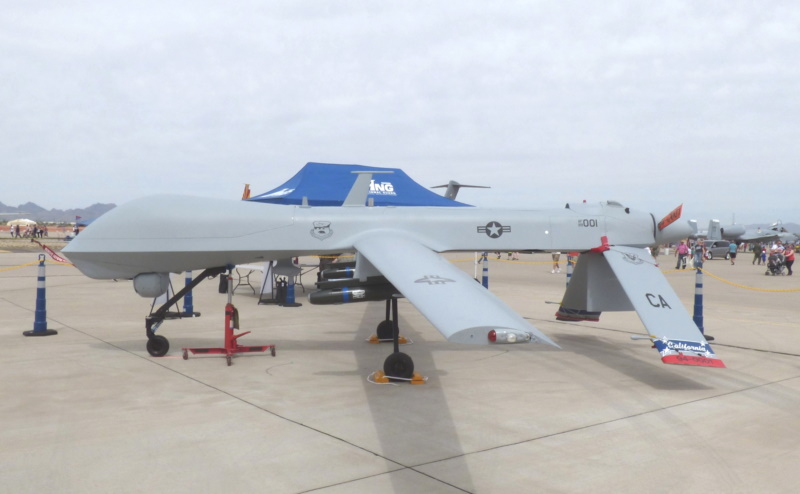
Given that a Predator was very unobtrusive and the Hellfire was supersonic, such a combination gave little warning of attack. An improved "Hellfire P" variant of the missile was fielded, featuring an "off boresight" seeker that could be gimbaled to get a target lock, eliminating the need to point the Predator at a target. This permitted faster targeting and a wider missile launch envelope. There was also a mysterious and ghastly "ninja" version of the Hellfire that popped out blades to shred into a target, reducing the possibility of collateral damage. The Air Force also considered other small munitions for carriage by the Predator.
There were concerns over arming the Predator, since it could then be regarded as a "cruise missile" and so would be subject to arms limitation treaties, but the utility of the Predator as a strike platform was very attractive, and the demand was there. After attacks on America on 11 September 2001 by terrorists associated with Saudi dissident Osama bin Laden and his Afghanistan-based al-Qaeda terrorist network, in early October of that year the US military began a campaign against Afghanistan intended to root out Osama and the al-Qaeda.
The Predator was a particularly important element in the campaign, being used by the USAF to locate high-priority targets for air strikes. The Predators were armed with Hellfires to ensure that if Osama or other al-Qaeda leadership were spotted, they could be attacked immediately. On 18 November 2001, a Predator was supporting an attack on a Taliban site when the drone's operators spotted enemy forces fleeing the site. A Hellfire was launched, killing dozens, including some Taliban leadership.
On 3 November 2002, an MQ-1L operating over Yemen spotted a car that was identified as carrying a high al-Qaeda official and five of his people. The Predator blasted the car with a Hellfire, killing all the occupants. The drone was operated by the CIA, but was being flown by a USAF pilot from a French military base in Djibouti, in the Horn of Africa. The attack was cued by observers on the ground.
The Stinger AAM was qualified as a store as well, though the military kept quiet about it. However, a Predator did use a Stinger in combat. On 23 December 2002, a Predator got into a "shoot-out" with an Iraqi MiG-25, firing a Stinger at it, while the MiG-25 fired an AAM back. It was the first time in history a drone engaged in air-to-air combat, but it was not an inspiring introduction: the Predator lost the shoot-out and was destroyed.
Of course, Predators were employed in the American invasion of Iraq in the spring of 2003. One fired a Hellfire at an antenna on the roof of the Iraqi propaganda ministry in Baghdad to get the propaganda minister, Mohammed Saeed al-Sahaf, off the air. The propaganda minister had acquired an international reputation for his colorful remarks, being known as "Baghdad Bob" to American forces, but the decision was taken to finally shut him up. The Predator-Hellfire was used because the propaganda ministry was close to the grand mosque, and nobody wanted to risk damaging it by using a more powerful munition.
Interestingly, some of the older Predators and Gnat-750s, as well as old Pioneer and Hunter drones, were stripped down to be used as decoys to provoke Iraqi defenses. After the occupation of Iraq, CIA-operated Predators and I-Gnats were launched from both Afghanistan and Iraq to probe Iran for evidence of a nuclear program, with one apparently lost in a crash in Iran in the summer of 2005. Predators were aggressively used in the Middle East, South Asia, and Africa, fueling an ongoing controversy over their use as a tool in "stealth warfare", conducted off the radar of public attention.
In any case, USAF Predators were actually "piloted" from Nellis AFB and Creech AFB in Nevada. Only a relatively small service and handling team deals with the machines "in theater". One pilot flying the Predator from Nellis who had been on the battle lines said the experience was much the same: "Physically, we may be in Vegas [Nellis AFB is next door to Las Vegas], but mentally we're flying over Iraq. It feels real."
The Air Force had been hard-pressed to train personnel to fly the Predators, and the pilots were badly overloaded, making retention troublesome. A "multiple aircraft" control system was introduced, allowing one pilot to control up to four Predators, with three machines operating on autopiloted search patterns while one is under direct control. The Predators were so heavily tasked that there weren't enough to go around for stateside training exercises, and so in 2009 the Air Force kitted up two Cessna 182 light civil aircraft with Predator EO-IR turrets to act as training surrogates for Predators. The two aircraft were operated by Civil Air Patrol volunteers under USAF supervision.
The Air Force also had a troublesome learning curve with the Predator itself, with a good number of them lost in accidents. Problems included loss of datalink connection from interference, and icing up in cold weather -- the Predator didn't have a high enough ceiling to fly over the weather. Later production Predators obtained by the USAF were fitted with de-icing systems, along with an uprated turbocharged engine, improved avionics, and a wing stretch to 16.84 meters (55 feet 4 inches). This improved "Block 1" version was referred to as the "RQ-1L", or the "MQ-1L" if it could carry munitions. Predators were also been given improved avionics, including updated sensors and a SIGINT system.
The Air Force has now phased out the Predator, the type having been withdrawn from service in 2018. Exactly what happened to the retired drones is unclear.
BACK_TO_TOP* With the Predator proving so useful, in the summer of 2005 the US Army, having initiated an "Extended Range / Multi-Purpose (ER/MP)" drone requirement a year earlier, formally decided to jump on board the bandwagon by awarding a contract to General Atomics for the "MQ-1C Gray Eagle" -- originally "Sky Warrior" -- a Predator with a heavy fuel (diesel / jet fuel) engine, wingspan increased to 17.1 meters (56 feet), and improved system redundancy. The Army had already operated I-Gnats in small numbers from 2003.
The MQ-1C could carry surveillance, communications relay, signals intelligence, electronic warfare, and strike payloads. The Thielert heavy-fuel engine was said to provide more horsepower (120 kW / 160 HP), better fuel efficiency, and greater reliability than the Rotax 912 gasoline engine, though apparently the major driving force for adopting the new engine was the fact that Army vehicles are diesels, and having to support a gasoline engine in the field would have been logistically troublesome. The Gray Eagle featured a tactical datalink along with its satellite comlink, and could carry a warload of four Hellfire missiles, twice that of the original Predator, total external load being 180 kilograms (400 pounds). Operational endurance was up to 25 hours.
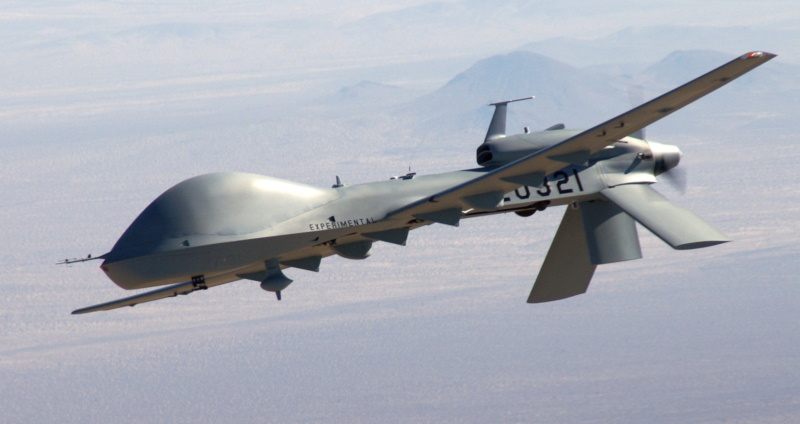
First flight was in the spring of 2008, with the initial "Block 0" MQ-1C in service in Iraq a month later for combat evaluation, being followed by improved blocks. An improved variant, the "Gray Eagle Extended Range (GE-ER)" -- originally just "Improved Gray Eagle (IGE)" -- first flew in 2013, and went into service in 2019. The IGE featured:
Gray Eagles in service have received avionics updates, notably to improve datalinking with other platforms. There has also been considerable work to improve reliability, which was poor at the outset. Not much has been said about support for new small smart munitions, such as the Advanced Precision Kill Weapon System (APKWS), a traditional 70-millimeter rocket with a laser guidance head.
Although the relationship between the Air Force and the Army over the close-support mission has been generally, if not always, good, Army brass also like to have their own air support assets. Something of a "turf battle" took place between the Army and the Air Force over the Predator, with the Air Force attempting to take over control of relatively capable drone assets such as the MQ-1C from the Army. The Army kept their Gray Eagles, and they remained in service at last notice.
BACK_TO_TOP* Given the limitations of the original Predator, to no surprise General Atomics came up with an improved "Predator B" series. Development began with the "Predator B-001", a proof-of concept aircraft, which performed its initial flight on 2 February 2001. The B-001 was powered by a Honeywell / Allied-Signal TPE-331-10T turboprop engine providing 712 kW (950 SHP). The Predator B-001 had a standard Predator airframe, except that the wings were stretched from 14.6 meters (48 feet) to 19.5 meters (64 feet).
Although General Atomics originally considered a Predator B variant powered by a turbofan engine, there was more interest in the turboprop configuration at the time, and the production machines retained the TP-331-10T engine. The production machines had a maximum ceiling of 15.8 kilometers (52,000 feet), and an endurance of 27 hours. The higher ceiling allowed the Predator B to fly above bad weather conditions. The turboprop engine was not only more powerful than the Rotax piston engine, it also had a much longer mean time between failures. The ground system remained much the same as that of the original RQ-1 / MQ-1 Predator. Cost was well more than that of a Predator A, but still a fraction of the cost of a piloted combat aircraft.
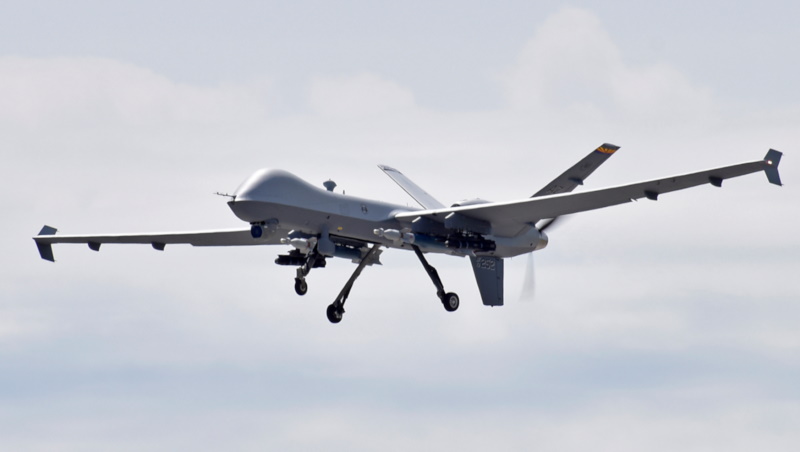
General Atomics had originally funded Predator B development with company money in anticipation of government interest and contracts, and the bet paid off. In October 2001, the US Air Force signed a contract with the company to purchase an initial pair of Predator Bs for evaluation. The Air Force then ran a competition in 2004 for a "Hunter-Killer" drone; the Air Force had an immediate need, the Predator B was pretty obviously what USAF brass had in mind and it was effectively available, so the Predator B handily won the award -- indeed, the competition had the feel of being no more than a formality.
The USAF designated the type the "MQ-9A Hunter-Killer" or "Reaper". Reapers were quickly fielded, performing combat evaluations in Afghanistan in late 2007. Several hundred of the drones have been obtained to date, with the Air Force intending to bring the fleet to 327 machines. The US Marines also acquired 1, it appears for evaluation.
___________________________________________________________________
GENERAL ATOMICS MQ-9B PREDATOR
___________________________________________________________________
wingspan:
20 meters (66 feet)
length:
11 meters (36 feet)
height:
3.6 meters (12 feet 6 inches)
empty weight:
2,225 kilograms (4,900 pounds)
max loaded weight:
4,760 kilograms (10,500 pounds)
maximum speed:
260 KPH (300 MPH / 260 KT)
service ceiling:
15,000 meters (50,000 feet)
endurance:
24 hours
___________________________________________________________________
As introduced, the MQ-9A was fitted with six stores pylons, with a respectable maximum external load of 1,360 kilograms (3,000 pounds). The inner stores pylons could carry a maximum of 680 kilograms (1,500 pounds) each, and were "wet" to allow carriage of external fuel tanks. The midwing stores pylons could carry a maximum of 270 kilograms (600 pounds) each, while the outer stores pylons could carry a maximum of 90 kilograms (200 pounds) each. Only four Hellfires were supported at the outset, but the number was later increased to eight. Endurance was 27 hours. Avionics, particularly the targeting system, were improved relative to the Predator A -- though the same ground systems could be used with both drones.
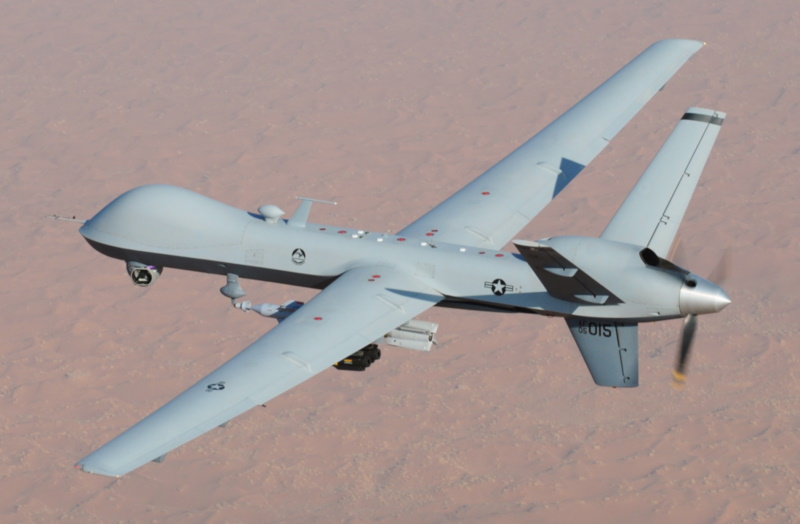
The Reaper gave the Air Force an enhanced "deadly persistence" capability, with the drone hanging over a combat area night and day, waiting for a target to present itself. In this role, an armed drone neatly complemented piloted strike aircraft. A piloted strike aircraft could be used to dump larger quantities of ordnance on a known target, while a cheaper drone could be kept in operation almost continuously, with ground controllers trading off in shifts, the drone carrying a light warload to engage targets of opportunity.
The Hellfire available at the time wasn't qualified for operation at cold temperatures found at high altitudes, nor did it have the range to hit targets from such altitudes. Other munitions carried by the Reaper include the 112-kilogram (250-pound) Small Diameter Bomb (SDB), or even the 225-kilogram (500-pound) version of the Joint Direct Attack Munition (JDAM) GPS-guided bomb for larger targets. New small smart munitions now entering service are also candidate Reaper stores, notably the Joint Air-to-Ground Missile (JAGM), the follow-on to Hellfire.
Along with carriage of the Stinger AAM, there has been some thought of carriage of the bigger Sidewinder, or even the long-range AIM-120 AMRAAM, as stores. The AMRAAM would require that the Reaper carry an improved radar with AMRAAM targeting and control capabilities, or at least datalink to other sensor platforms. General Atomics has published ads showing the Reaper armed with twin 225-kilogram guided bombs, eight Hellfires, and two Sidewinders, demonstrating just how powerful a punch the machine can pack.
The Reaper was, as noted, primarily obtained for the armed persistence role, but of course it could perform surveillance as well. It could carry optical / infrared or SAR reconnaissance pods, and was used for the development of the "Gorgon Stare" pod, which included a dozen video cameras and could maintain a constant view of a city-sized area, relaying multiple scenes from the target area to multiple users simultaneously. More recent sensors have incorporated artificial intelligence (AI) capabilities to make them "smarter", able to pick out and identify specific targets.
In addition, the Reaper has been evaluated with electronic warfare payloads. A "self-protection pod (SPP)" was introduced in 2020, containing threat-warning systems; a directed infrared beam to dazzle heat-seeking missiles; chaff-flare dispensers; and a dispenser for small active decoys. The flight control system has been updated, enhancing the ability to perform autonomous take-offs and landings. In 2022, General Atomics introduced a "short take-off & landing (STOL)" kit for the Reaper, involving modifications to the wings and tail that could be easily field-installed. It was intended for naval use, off aircraft carriers; the modifications reduced flight endurance.
Along with the standard Predator, the Air Force also obtained an "MQ-9A Reaper ER", with stronger landing gear and the ability to carry an external tank under each wing, giving it a maximum endurance of over 30 hours. It also had a water-methanol injection engine system to boost take-off power, and a four-bladed prop. Introduction to service was in 2015.
An "MQ-9A Block 5" Reaper was introduced to service in 2017, this version featuring greater MTOW for more fuel and payload, with the stronger landing gear; a heftier starter-generator to provide more electrical power; improved avionics; and a refined payload integration scheme. A further improvement was to permit take-offs and landings to be conducted over a satellite link. Before that, although flights could be controlled by satellite, landings had to be controlled by a ground station at the operational base, which complicated deployment. Users have progressively upgraded their earlier machines to Block 5 configuration.
The US Marines have also obtained eight Reaper ERs, with initial deliveries in 2023. The USAF is thinking about what will replace the Reaper -- but that won't happen for some time.
* To support foreign sales, General Atomics introduced an "MQ-9B Skyguardian" derivative of the Reaper -- originally the "Certifiable Predator B (CPB)" -- enhanced and qualified for operations in civil airspace. It had a wingspan of 24 meters (78.7 feet), a ruggedized airframe, a maximum take-off weight of 5,670 kilograms (12,500 pounds), and an external load capability of 1,815 kilograms (4,000 pounds), including external fuel tanks. It was powered by a Honeywell TPE331-10 turboprop, with 700 kW (940 HP) take-off power, and had an endurance of 40 hours. Development began in 2012, with first flight in late 2016. The first production item self-deployed across the Atlantic to Britain in 2018.
Britain originally purchased two Reapers in 2006, for an urgent operational requirement in Afghanistan, with the ultimate total rising to eleven, one being lost in a crash. British Reapers have carried Hellfires and used them in combat. Britain retired its 10 surviving Reapers in 2024, being replaced with 16 armed Skyguardians, designated "Protector Reconnaissance / Ground Attack 1 (RG.1)" in UK service. They could carry the British-made Brimstone missile, a re-engineered and improved Hellfire; they also could carry a SAR or SIGINT system. The first Protector performed its initial flight in 2020, with deliveries from 2022.
There have been a number of other export users of the MQ-9:
In addition, several US government civilian agencies fly or have flown the Reaper. The US Forest Service and NASA conducted trials in 2006 with a leased Predator B, leading to operations in 2007 with a Reaper obtained from the USAF. This machine was renamed "Ikhana", from the Choctaw word for "intelligent" or "aware"; the name "Reaper" seemed a bit too warlike for a civil application. The Ikhana carried a NASA-designed infrared sensor package for fire mapping: although a standard Reaper can carry a military EO-IR imager, such are not tailored to observe big, hot fires. The sensor package relayed imagery back to a ground station in real-time to allow warnings to be sent to fire-fighters. NASA not surprisingly has also considered a range of other missions for the Ikhana.
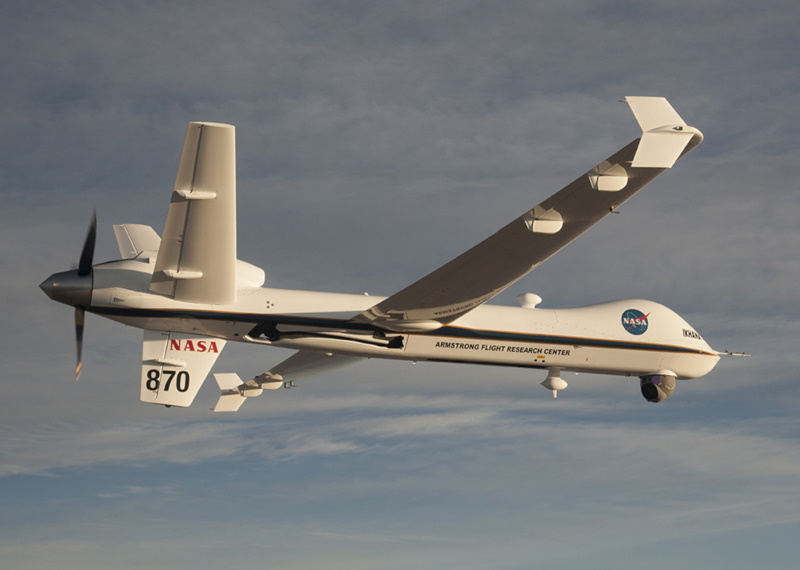
The US National Oceanographic & Atmospheric Administration (NOAA) has been working on collaborative drone efforts with NASA for weather and climate research. The two agencies have long been partners on weather satellites, and drones would only be an extension of existing practice. In addition, NASA has used the Ikhana to pioneer operations of large drones in commercial airspace.
The US Department of Homeland Security (DHS) is another user of the Predator B, with about half a dozen in service for border patrol and disaster response. In 2010, the DHS's Customs & Border Protection (CBP) organization evaluated a Predator B for hunting drug smugglers, with the machine fitted with a belly fairing for a Raytheon AN/APS-134 SeaVue radar, plus wingtip aerials for UHF/VHF radio links, with this variant known as the "Guardian".
The US Missile Defense Agency (MDA) has been experimenting since 2009 with a set of Predator Bs fitted with an "Airborne Infrared (ABIR)" system in a glass nose to track missile launched for targeting by anti-missile defense systems. There's no commitment to deployment.
General Atomics designed a navalized version of the Predator B, named the "Mariner", for carrier operations, and flew a demonstrator, the primary motivation being the US Navy "Broad Area Maritime Surveillance (BAMS)" program. The production Mariner would be turboprop-powered, with folding wings for carrier storage; shorter and more rugged landing gear; an arresting hook; cut-down or eliminated ventral flight surfaces; the sensor suite including maritime surveillance radar and an ELINT system; and six stores pylons with a total load of 1,360 kilograms (3,000 pounds).
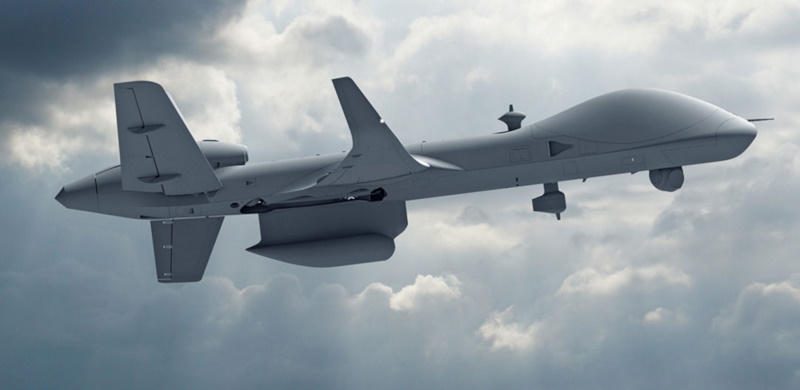
The BAMS award was won by the Northrop Grumman RQ-4N, as discussed later. However, General Atomics didn't give up the Mariner, renaming it the "SeaGuardian". Systems have been updated, most notably for support of the advanced Leonardo Seaspray 7500 AESA (active electronically scanned array) radar. An AESA can be thought of as a radio-frequency (RF) "array processor", composed of a grid of interconnected "transmit-receive" modules, each with its own RF, processing, and control electronics. An AESA can perform communications, jamming, or sensing functions in through juggling the use of its modules.
Configurations being proposed for the Seaguardian envision it as carrying a pod under each wing for active and passive sonar buoys, allowing it to spot and track submarines. Mine countermeasures could be another mission.
BACK_TO_TOP* In late 2021, General Atomics revealed a derivative of the MQ-9, known simply by the company label of "Mojave". It looked much like a Reaper, with the upright vee tail, and was turboprop-powered -- but it had a more substantial plank-like wing, and ruggedized landing gear. It was optimized for short take-offs and landings off of rough strips, clearly being intended to support expeditionary forces.
Unlike the Reaper, the Mojave was fitted with a Rolls-Royce Allison 250 turboprop engine with 335 kW (450 HP). The wing, which had a span of 15.8 meters (52 feet), had leading-edge slats and double-slotted flaps. There were three hardpoints on each wing, with images showing carriage of 16 Hellfires. It has even been flown with 7.62-millimeter Minigun pods, though that armament fit might have been promotional; it's not obvious how useful a drone would be for strafing attacks. No mention has been made of sales to date.
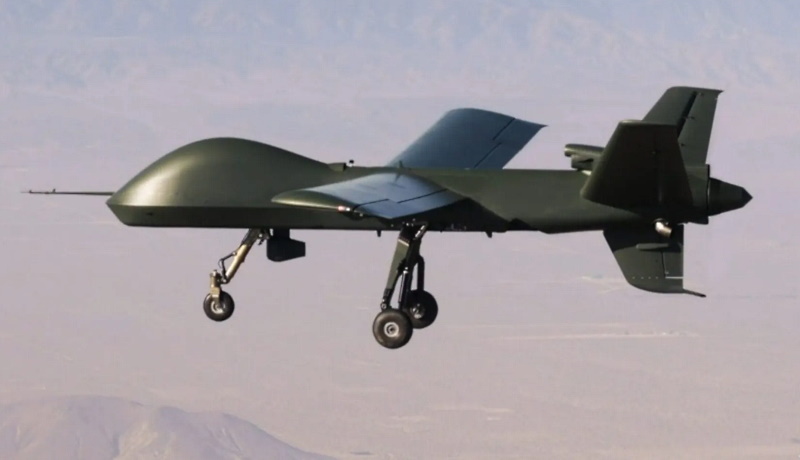
* Although General Atomics did backtrack on development of a turbofan-powered Predator variant, the idea didn't die out. The company kept quiet about the effort -- but in the spring of 2009 announced that a "Predator C" or "Avenger" prototype had performed its first flight on 4 April 2009. It was followed by a second prototype in 2012, closer to intended production spec, with a 1.2-meter (4-foot) fuselage stretch and a loaded weight about 10% bigger.
The Avenger clearly looked like a member of the Predator family, but it also was clearly designed for stealth. It had relatively smooth contours, with the engine -- a Pratt & Whitney Canada (PWC) PW545B turbofan with 21.3 kN (2,175 kgp / 4,800 lbf) thrust -- carried on the back and using a wide exhaust, hidden behind an upright vee tail with "all moving" tail surfaces. It also had retractable tricycle landing gear -- all with single wheels, the nose gear retracting backwards, the main gear hinging in from the wings towards the fuselage -- and even a weapons bay to permit stealthy carriage of stores. Additional fuel tanks could be stored in the weapons bay, and a conformal sensor pack could be plugged into it. External stores could be carried when stealth was not required. Total internal payload was given as 1,350 kilograms (3,000 pounds), with an equivalent external payload capacity.
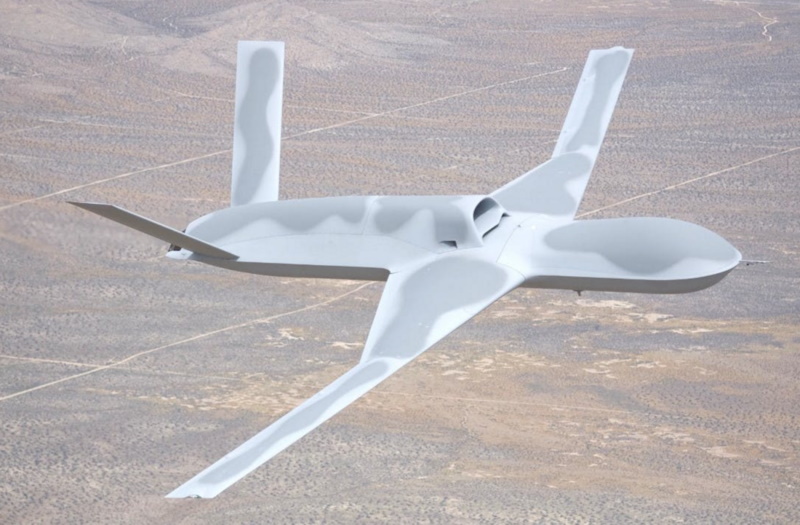
The Avenger had a length of 13.4 meters (44 feet) and a wingspan of 20.1 meters (66 feet). The wings had a sweep of 17 degrees; they could be folded for compact storage. Fuel carriage was split between the fuselage and inner wing sections. Endurance was cited as up to 20 hours, top speed in excess of 740 KPH (460 MPH / 400 KT), and maximum altitude as 18,300 meters (60,000 feet). A total of at least four prototypes was built.
General Atomics developed the Avenger on company funds, with an eye towards sales to the US military. The Air Force obtained the first prototype in 2011 for evaluation, but decided not to procure the type, finding the MQ-9 Reaper satisfactory to needs. In 2010, General Atomics announced a "Sea Avenger" for carrier-based use, featuring navalizations such as catapult attachment and arresting hook. However, US Navy interest proved stillborn as well. One prototype was modified to an "Avenger ER" configuration, with:
In 2018, the Avenger ER set an endurance record of 23.4 hours. In 2023, an Avenger was experimentally fitted with an AI flight-control system. General Atomics has been pitching the Avenger on the international market, but still has made few sales.
BACK_TO_TOP